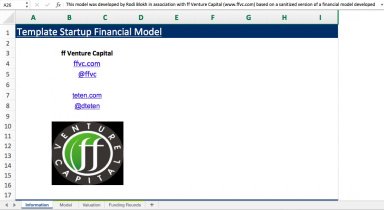
Last version published: 26/01/2017 14:48
Publication number: ELQ-80767-2
View all versions & Certificate

Startup Financial Model Template
A simple financial model for an early-stage startup/anyone building a model for a company
Further information
The model is designed to give you the following standard financial statements:
1/ The income statement sheet is built to configure both your expenses and revenues at the moment changes take place. As opposed to the Cash Flow statement, that takes measure of the actual money movement, the income statement saves money transaction processes and forecasts things such as depreciation, that don’t actually show yearly flows of cash, but instead are measured in multiple years.
2/ The balance sheet gives you a view of your company at a particular date, it tells you how many assets are available at the given time, but not necessarily related to previous or later dates. This sections allows you to see listed assets, liabilities and your equity.
3/ The cashflow statement is key for a startup given that it tells you whether you can or you can’t pay the crucial bills, for example, paying your employees.
4/ To further make the model whole, we added a Discounted Cash flow valuation tab, but this may not be very important for startups. In the end of it all, forecasting cash flows for startups is rather based on probabilities or even guessing. Startups however can see their valuation clearer if discusses with an investor, rather than a DCF.
5/ The funding round tab, the last tab on your model, should help you when evaluating the options available for raising capital. One important thing here would be that your current shareholders will be diluted if your future capital raises, for this reason the model will show you what the final equity share percentage will be after you have gone through your planned funding stages.
The downside is that typically, financial models are designed for more established businesses so the assumptions and calculations in these cases are not suitable for startups (i.e terminal growth and EBITDA multiples). The model should be a strong enough option for entrepreneurs that want to analyse and evaluate the operational side to their business, but it does not aim at limiting against pivots and tech disruptions.




